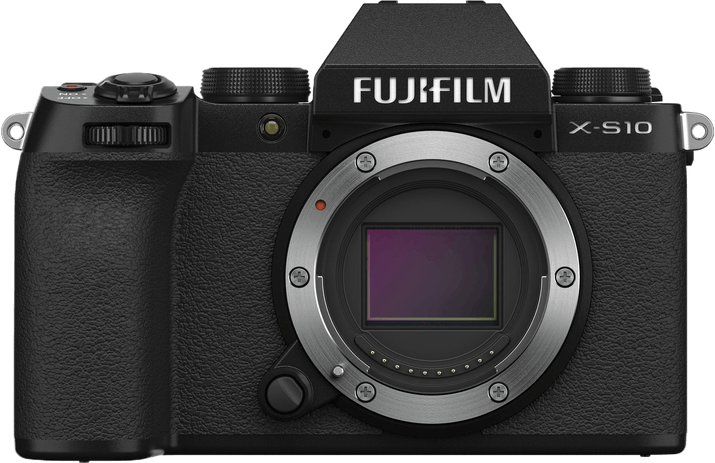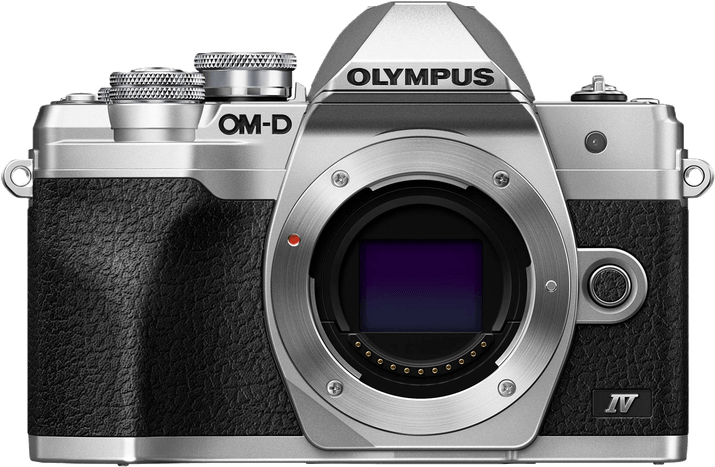Fujifilm X-S10 vs Olympus OM-D E-M10 Mark IV Comparison
Fujifilm X-S10

Olympus OM-D E-M10 Mark IV

The Fujifilm X-S10 outperforms the Olympus OM-D E-M10 Mark IV with a score of 69/100 compared to 63/100. Both cameras are mirrorless and were released in 2020, with the X-S10 being announced on October 15th and the E-M10 Mark IV on August 4th. They share similarities in size, with the X-S10 measuring 126 x 85 x 65mm and the E-M10 Mark IV at 122 x 84 x 49mm.
The X-S10 takes the lead with its higher score, which can be attributed to its better overall performance. However, the E-M10 Mark IV does have a lighter weight of 383g, making it more portable than the X-S10, which weighs 465g.
Price-wise, the Olympus OM-D E-M10 Mark IV is more affordable at $699, while the Fujifilm X-S10 comes with a heftier price tag of $999. Despite the price difference, the X-S10’s superior performance justifies its higher cost. Ultimately, the Fujifilm X-S10 is the better camera, but the Olympus OM-D E-M10 Mark IV still offers a lighter and more budget-friendly option for those who prioritize portability and affordability.
Fujifilm X-S10 vs Olympus OM-D E-M10 Mark IV Overview and Optics
The Fujifilm X-S10 outperforms the Olympus OM-D E-M10 Mark IV in optics, scoring 72/100 compared to the Olympus’ 63/100. Both cameras share common specifications, such as CMOS sensors, processors, image stabilization, and aspect ratios of 3:2 for the Fujifilm and 4:3 for the Olympus.
The Fujifilm X-S10 excels with its 26 megapixels, higher shooting speed of 20 frames per second, APS-C sensor size, and Fujifilm X lens mount. These features contribute to better image quality and performance, making the X-S10 the superior choice in this comparison.
On the other hand, the Olympus OM-D E-M10 Mark IV has a lower 20-megapixel count, slower shooting speed of 15 frames per second, smaller Micro Four Thirds sensor size, and a Micro 4/3 lens mount. However, it does have a DXOMARK score of 73 for its sensor, providing an objective measure of its quality, while the Fujifilm X-S10 does not have a DXOMARK score.
Despite the lower score, the Olympus OM-D E-M10 Mark IV still offers quality optics and features that may appeal to some users, particularly those who prefer a smaller, lighter camera with a more extensive range of compatible lenses due to its Micro 4/3 lens mount.
In this comparison, the Fujifilm X-S10 emerges as the better camera in terms of optics, with its higher megapixel count, faster shooting speed, and larger sensor size. However, the Olympus OM-D E-M10 Mark IV remains a viable option for those who prioritize a compact system with a wider lens selection.
Fujifilm X-S10 vs Olympus OM-D E-M10 Mark IV Video Performance
The Fujifilm X-S10 outperforms the Olympus OM-D E-M10 Mark IV in video capabilities, scoring 91/100 compared to the Olympus’s score of 83/100. Both cameras share some common video specifications, including 4K video resolution and built-in time-lapse functionality. However, the Fujifilm X-S10 surpasses the Olympus OM-D E-M10 Mark IV in several aspects, making it the superior choice for video recording.
The Fujifilm X-S10 has a higher maximum video dimension of 4096 x 2160, compared to the Olympus’s 3840 x 2160. This larger video dimension allows the Fujifilm X-S10 to capture more detail and provide a higher quality video output. Additionally, the Fujifilm X-S10 boasts a maximum video frame rate of 240fps, significantly higher than the Olympus’s 60fps. The higher frame rate enables the Fujifilm X-S10 to record smoother videos and allows for better slow-motion playback.
On the other hand, the Olympus OM-D E-M10 Mark IV still performs well in video recording with its 4K resolution and time-lapse functionality. While its video capabilities are not as advanced as the Fujifilm X-S10, the Olympus OM-D E-M10 Mark IV may be suitable for users who prioritize other camera features or have a limited budget.
Considering the video specifications and performance, the Fujifilm X-S10 is the better choice for users who prioritize video recording capabilities. Its higher video dimensions and frame rate provide superior video quality and smoothness compared to the Olympus OM-D E-M10 Mark IV. However, the Olympus OM-D E-M10 Mark IV remains a viable option for users who require decent video performance without the need for advanced video features.
Fujifilm X-S10 vs Olympus OM-D E-M10 Mark IV Features and Benefits
The Fujifilm X-S10 and the Olympus OM-D E-M10 Mark IV both score 70/100 in terms of features. Despite having the same score, each camera offers unique advantages over the other.
Both cameras share some specifications, such as a 3-inch screen size, 1040000-dot screen resolution, touchscreen functionality, flip screen, and Bluetooth connectivity. However, there are differences that set them apart.
The Fujifilm X-S10 surpasses the Olympus OM-D E-M10 Mark IV in certain aspects. Although it does not have built-in Wi-Fi, the X-S10’s Bluetooth connectivity compensates for this by providing a means to transfer files and control the camera remotely. Additionally, the X-S10 boasts a more robust build and better ergonomics, making it more comfortable to use during long shooting sessions.
On the other hand, the Olympus OM-D E-M10 Mark IV has Wi-Fi connectivity, offering photographers an additional option for transferring files and controlling the camera remotely. This feature can be especially useful for those who prefer using Wi-Fi over Bluetooth. However, the E-M10 Mark IV falls short in terms of build quality and ergonomics compared to the X-S10.
Taking into account the unique advantages of each camera, the choice between the Fujifilm X-S10 and the Olympus OM-D E-M10 Mark IV depends on individual preferences. Photographers who value build quality and ergonomics may opt for the X-S10, while those who prioritize Wi-Fi connectivity might lean towards the E-M10 Mark IV. Regardless of the choice, both cameras offer a solid set of features worthy of consideration.
Fujifilm X-S10 vs Olympus OM-D E-M10 Mark IV Storage and Battery
The Fujifilm X-S10 and Olympus OM-D E-M10 Mark IV both score 35/100 in storage and battery. They share similarities in this category, as each camera has one memory card slot and supports USB charging. Both cameras accept SD, SDHC, and SDXC memory cards, but the Olympus OM-D E-M10 Mark IV has an advantage with UHS-II compatibility, allowing for faster data transfer speeds.
However, the Fujifilm X-S10’s NP-126S battery provides 325 shots per charge, while the Olympus OM-D E-M10 Mark IV’s BLS-50 battery lasts for a slightly longer 360 shots. This difference in battery life may be beneficial for photographers who require extended shooting times.
Despite their equal scores, the Olympus OM-D E-M10 Mark IV edges out the Fujifilm X-S10 in storage with its UHS-II compatibility and marginally better battery life. However, these differences are minor, and both cameras offer reliable storage and battery performance for most photography needs.
Fujifilm X-S10 vs Olympus OM-D E-M10 Mark IV – Our Verdict
Are you still undecided about which camera is right for you? Have a look at these popular comparisons that feature the Fujifilm X-S10 or the Olympus OM-D E-M10 Mark IV:

